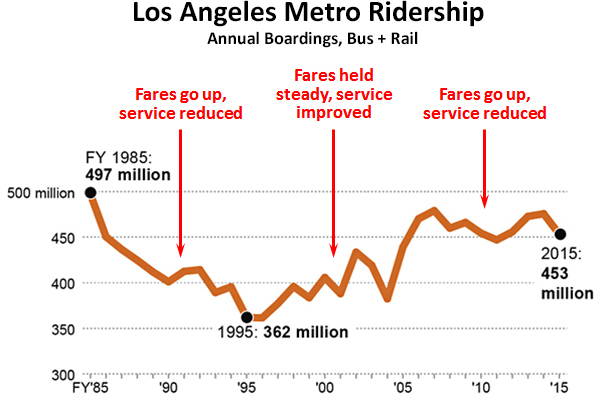Tyler Cowen point us to Wendell Cox, who says that aside from New York City, mass transit ridership in the US is looking grim:
If New York City Subway ridership had remained at its 2005 level, overall transit ridership would have decreased from 9.8 billion in 2005 to 9.6 billion in 2015. The modern
record of 10.7 billion rides would never have been approached.
Despite spending billions of dollars on new rail lines in LA, mass transit in Southern California certainly fits this bill:
The Los Angeles County Metropolitan Transportation Authority, the region’s largest carrier, lost more than 10% of its boardings from 2006 to 2015, a decline that appears to be accelerating….In Orange County, bus ridership plummeted 30% in the last seven years….Southern California certainly isn’t alone. Public transportation use in many U.S. cities, including Chicago and Washington, D.C., has slumped in the last few years.
But all is not lost. If you take a longer look at Los Angeles transit, it turns out there are things you can do to increase ridership. It’s complicated, though, so you’ll need to read carefully:
Thirty years ago, [Metro] handled almost 500 million annual bus boardings in Los Angeles County. In the decade that followed…Metro raised fares and cut bus service hours. [Ridership during this period declined from 497 million to 362 million. –ed.]
In 1994, an organization that represented bus riders sued Metro in federal court….Metro agreed to stop raising fares for 10 years and relieve overcrowding by adding more than 1 million hours of bus service. Ridership soared. Metro buses and trains recorded about 492 million boardings in 2006, the most since 1985.
But from 2009 to 2011, several years after federal oversight ended and during the Great Recession, the agency raised fares and cut bus service by 900,000 hours. By the end of 2015, ridership had fallen 10% from 2006, with the steepest declines coming in the last two years.
Hmmm. There’s an answer in there somewhere. We just need to tease it out. Here’s an annotated version of the full chart that I excerpted above. Maybe that will help.
















